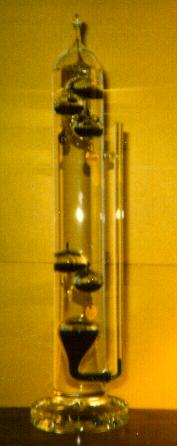I have a thermometer made of a column of fluid containing seven spheres of fluid that rise and fall according to the temperature (commonly known as a Galileo thermometer). How does this work? — LS, Conroe, TX
A Galileo thermometer combines Archimedes’ principle with the fact that liquids generally expand faster with increasing temperature than solids do. Each sphere in the thermometer has an average density (a mass divided by volume) that is very close to that of the fluid in the thermometer. As stated in Archimedes’ principle, if the sphere’s average density is less than that of the fluid, the sphere floats and if the sphere’s average density is more than that of the fluid, it sinks. But the fluid’s density changes relatively quickly with temperature, becoming less with each additional degree. Thus as the temperature of the thermometer rises, the spheres have more and more trouble floating. Each sphere’s density is carefully adjusted so that it begins to sink as soon as the thermometer’s temperature exceeds a certain value. At that value, the expanding fluid’s density becomes less than the average density of the sphere and the sphere no longer floats. The spheres also expand with increasing temperature, but not as much as the fluid.
Here is a picture of a combined Galileo thermometer and simple barometer.  In addition to measuring the temperature with floating spheres, this device measures the outside air pressure with a column of dark liquid. It has a trapped volume of air that pushes the liquid (visible at the bottom of the unit) up a vertical pipe when the outside air pressure drops. The owner of this unit would like to know its history and origin, so if you have any information about it, please let me know.
In addition to measuring the temperature with floating spheres, this device measures the outside air pressure with a column of dark liquid. It has a trapped volume of air that pushes the liquid (visible at the bottom of the unit) up a vertical pipe when the outside air pressure drops. The owner of this unit would like to know its history and origin, so if you have any information about it, please let me know.